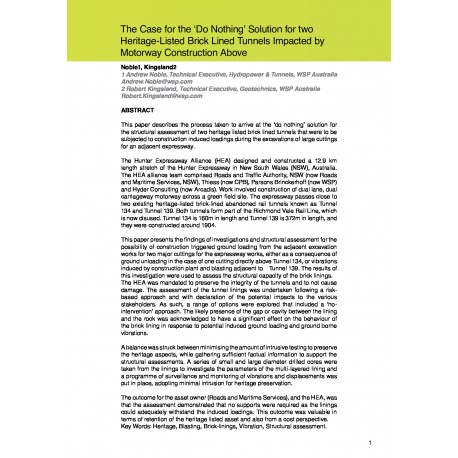Cart
0
0
No document
0,00 €
Total
Document successfully added to your shopping cart
Quantity
Total
There are 0 items in your cart.
There is 1 item in your cart.
Total documents
Total shipping
To be determined
Total
Search & filter
Search for a publication
Search & filter
The Case for the ‘Do Nothing’ Solution for two Heritage-Listed Brick Lined Tunnels Impacted by Motorway Construction Above
370_the_case_for_the_‘do_nothing
This paper describes the process taken to arrive at the ‘do nothing’ solution for the structural assessment of two heritage listed brick lined tunnels that were to be subjected to construction induced loadings during the excavations of large cuttings for an adjacent expressway.The Hunter Expressway Alliance (HEA) designed and constructed a 12.9 km length stretch of the Hunter Expressway in New South Wales (NSW), Australia. The HEA alliance team comprised Roads and Traffic Authority, NSW (now Roads and Maritime Services, NSW), Thiess (now CPB), Parsons Brinckerhoff (now WSP) and Hyder Consulting (now Arcadis). Work involved construction of dual lane, dual carriageway motorway across a green field site. The expressway passes close to two existing heritage-listed brick-lined abandoned rail tunnels known as Tunnel 134 and Tunnel 139. Both tunnels form part of the Richmond Vale Rail Line, which is now disused. Tunnel 134 is 160m in length and Tunnel 139 is 372m in length, and they were constructed around 1904.This paper presents the findings of investigations and structural assessment for the possibility of construction triggered ground loading from the adjacent excavation works for two major cuttings for the expressway works, either as a consequence of ground unloading in the case of one cutting directly above Tunnel 134, or vibrations induced by construction plant and blasting adjacent to Tunnel 139. The results of this investigation were used to assess the structural capacity of the brick linings.The HEA was mandated to preserve the integrity of the tunnels and to not cause damage. The assessment of the tunnel linings was undertaken following a riskbased approach and with declaration of the potential impacts to the various stakeholders. As such, a range of options were explored that included a ‘nointervention’ approach. The likely presence of the gap or cavity between the lining and the rock was acknowledged to have a significant effect on the behaviour of the brick lining in response to potential induced ground loading and ground borne vibrations. A balance was struck between minimising the amount of intrusive testing to preserve the heritage aspects, while gathering sufficient factual information to support the structural assessments. A series of small and large diameter drilled cores were taken from the linings to investigate the parameters of the multi-layered lining and a programme of surveillance and monitoring of vibrations and displacements was put in place, adopting minimal intrusion for heritage preservation.The outcome for the asset owner (Roads and Maritime Services), and the HEA, was that the assessment demonstrated that no supports were required as the linings could adequately withstand the induced loadings.




